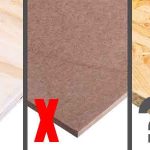The DIY Fix is reader supported. When you buy after clicking a link on our site, we may earn an affiliate commission.
There is a belief that woodworm will only live in damp timber. This is because it is common to find infestations living in wood that is moist and damp.
A woodworm infestation is a real concern for any homeowner. But it makes sense to learn more about their behaviour and what kind of timber they prefer. This makes it possible to keep an eye out for infestations, instead of just assuming your home is dry and not at risk.
The reality is, that woodworm will make a home in many different types of timber. Different species like certain types of wood, and there is a risk that some species will attack dry wood. This means they may infest dry timbers, such as joists and floorboards.
There are also some species that will specifically target dry wood. But most do prefer damp timber.
However, even these damp preferring species could still attack dryer wood if the other conditions were right.
Which Species of Woodworm Like Dry Wood?

As we mentioned previously, there are certain species that will only attack dry wood.
The House Longhorn Beetle will cause the most damage out of all woodworm species. This wood-boring insect will usually target the sapwood of dry softwood. They are often found in roof timbers as these remain dry due to the conditions inside most homes. This is not a common species found in the UK, although it is possible to find it in certain areas in the south of England.
As they prefer dry wood, they are found in loft timbers and timbers in dry conditions. Here they will attack the timber which can lead to severe damage and structural issues.
They are mostly found in new homes, due to timber brought into the home, that already contains eggs.
Which Species of Woodworm Like Damp Wood?
Most people would assume that woodworm prefer damp wood, and this is true for most species. While it’s possible to find woodworm in dry wood, they do prefer wood that is damp and soft.
The Common Furniture Beetle is the most common species of woodworm. This type of woodworm prefers softwood that is damp. So, it’s common to find them in damp structural timbers and old furniture, as well as floorboards.
The Death Watch Beetle is a species of woodworm that is very invasive and is often found in old buildings. The species does prefer damp conditions, especially timber that suffers from rot and decay. This makes the timber easier to attack and lay eggs in. The larvae work their way into the centre of timber and cause a lot of damage that you will not see externally.
Powderpost Beetles are often found in timber that is damp, such as wood that comes from timber yards and is exposed to the elements. They will attack furniture and flooring and they prefer hardwood. The wood they attack must have a high starch content, so they often attack woods like oak and elm, that are less than 10-15 years old.
Another wood boring insect that likes damp wood, is the Wood boring Weevil. This species will attack damp softwood and hardwood that has signs of decay. If fungus is present, then they are even more likely to attack.
Commonly, you will find them in areas that lack airflow such as cellars and wood that meets damp walls and floors.
Other Risks of Damp Wood
It is clear to see that woodworm does prefer to attack damp wood, and a woodworm infestation can cause a lot of damage. But damp also brings with it several potential issues.
When damp is present, it will begin to soften the wood. The excess moisture creates the perfect conditions for bacteria and fungi to grow. Over longer periods, it can also lead to rot.
As rot takes hold, the wood begins to weaken and will become brittle. This can cause structural problems, that could potentially become dangerous.
It’s also possible for damp to spread to other areas of the home. This means that damp in floor joists can spread to floorboards, skirting boards and even walls. Once damp sets in, it can also leave a nasty smell. Along with this, damp can also be difficult to find, so you should aim to keep your home warm and free of excess moisture.
Conclusion
Woodworm is common in wood and timber that is damp and moist. This is because the wood becomes soft and is easier to attack. But certain species actually prefer to attack dry wood, which is why they can often go unnoticed.
As a result, people don’t often consider woodworm if there isn’t already an issue with damp It’s important to understand the signs of woodworm and to remember that they can cause a lot of damage in both damp and dry wood.




